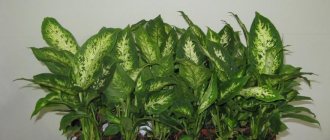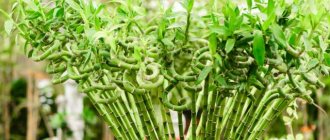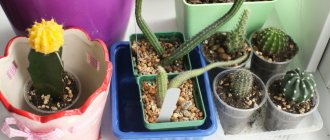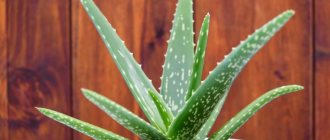In fact, the correct name for the flower is “guzmania”. But in everyday life the pronunciation with the letter “Z” has taken root. Beginning flower growers are simply sure that guzmania belongs to the category of finicky plants. Therefore, in our climate the tropical beauty is extremely uncomfortable. As practice has shown, this is a serious misconception. Guzmania does not pose any particular difficulties and tolerates climate changes favorably. But for her comfortable living, flower growers recommend creating certain conditions.
General information
The houseplant guzmania, or guzmania, is a herbaceous epiphyte belonging to the Bromeliad family. This family is quite extensive and includes about 200 species, distributed in Brazil, India and Central America.
The leaves are long (up to 45 cm), pointed, monochromatic. The guzmania flower forms a dense funnel-shaped rosette with a recess for collecting water. In this case, the roots practically do not participate in the nutrition and supply of moisture to the plant. On window sills the plant reaches a maximum of 50 cm in height.
The flowers of this epiphyte are small, inconspicuous, white or yellowish. This exotic beauty attracts attention with its bright bracts, which, depending on the variety, can be brown, burgundy, orange, or scarlet. The bracts are shorter than the rest of the leaves, making them appear like a red flower in the middle of a neat green rosette.
Watering a plant grown on a support
If guzmania is grown on a support - a bromeliad tree, it is watered in a different way.
Periodically - once every 10 days - the plant is removed from its support and immersed in a basin of water, which should be the same as during normal watering, that is, settled and warm. The plant is kept in water until completely saturated. Then the excess water is allowed to drain and the guzmania is returned to its support.
Main types and varieties of Guzmania
Of the numerous representatives of Bromeliads, the following varieties have taken root in indoor floriculture:
- Guzmania reed. In nature, it is a stemless plant with weak roots and short red bracts. Based on this species, such popular groups of Guzmania varieties as Minor (Minor Rondo), Mix and Tempo were bred. These are low plants with bracts of different colors - yellow, pink, golden-green.
- Guzmania is blood red. Its lanceolate, downward-bending leaves form a dense, goblet-shaped rosette. The plant is compact, about 20 cm in height. Flowers without peduncles are located directly in the leaf rosette. The bracts are red or yellow. During flowering, all the leaves of the rosette become colored, and the color is uneven.
- Guzmania mosaic. It grows up to 50 cm. Its long, up to 80 cm, leaves are decorated with transverse light stripes. Peduncles are low, erect; The flowers are white, small, protected by yellow sepals. The inflorescences are large and dense, attractive. The bracts are bright pink.
- Guzmania Donnell-Smith. A compact plant with beautiful dark green leaves and a graceful rosette. The inflorescence is a panicle. This guzmania began to be grown as an indoor flower relatively recently.
Breeders are actively working to develop new hybrids and varieties and improve their qualities. For example, Guzmania Ostara, obtained by crossing different natural species, is capable of “holding” flower stalks for up to six months without losing its decorative effect.
Description of the plant
In nature, guzmania is found in India, Central and South America, preferring plains covered with tropical forests. It received its name in honor of the famous Spanish traveler and naturalist A. Guzman.
Appearance and origin
Guzmania belongs to the Bromeliad family, that is, it is a fairly close relative of the pineapple. This is an epiphytic flower. Such plants are also called atmospheric plants, because they receive all the necessary moisture not from the substrate, but from the air. Guzmania's roots are underdeveloped and are needed only to more reliably cling to branches, trunks of fallen trees or cracks in stones.
In the wild, Guzmania can most often be found growing on a tree.
Guzmania has no stem; it consists of long and narrow, but very dense leaves, similar to belts. They form a rosette, similar to a tall narrow glass. In nature, dew and rainwater accumulate in it - this is an alternative to the moisture received by other plants from the soil.
A peduncle covered with smaller leaves emerges from the center of the rosette, and on its crown are bright bracts of different shades of red (sometimes orange or yellow). They protect small white flowers.
What many gardeners consider to be the bright petals of large flowers are actually bracts
Guzmania is an evergreen plant. Some species may have spots or stripes of a darker shade on the leaves. Under natural conditions, the rosette reaches 0.5 m in diameter and is used as a “drinker” by tropical birds. Guzmania blooms for a very long time, up to 20 weeks, and all this time it pleases with large bracts of bright colors - from sunny yellow to dark red.
The bright bracts of guzmania delight the gardener's eye for a long time
How to care for Guzmania
When caring for Guzmania at home, it is important to recreate its natural living conditions as accurately as possible. Then the plant will form a dense, beautiful rosette and bloom in a timely manner.
Lighting, temperature and humidity
Guzmania requires light, so the correct location of the pot is important for successful cultivation. The plant needs bright, but diffused light, without direct sunlight. Windows of western and eastern orientation will be optimal for it.
It is important to remember that Guzmania is native to the tropics, which means it prefers high humidity and temperature. The optimal range for the summer period is 20-25 degrees. In winter, the indoor air should not be colder than 16 degrees. In summer, Guzmania needs daily spraying; you can place it on a tray with wet expanded clay or sphagnum.
How to water Guzmania and when to fertilize
To water Guzmania, use settled water heated to room temperature. Unlike most plants, they water not the soil, but the rosette, filling the funnel-shaped depression at its top 2/3 with water. In the summer, water is left, renewing its supply daily. In winter, with a decrease in the amount of light and a drop in temperature, excess water is drained after 30 minutes; The plant is “watered” 2 times a week. The soil can be slightly moistened only during the summer heat to further increase the air humidity around the outlet.
Guzmania, as a rule, does not need additional feeding. In spring and summer, you can apply fertilizer with a high potassium content once a month, which speeds up the appearance of flower stalks. Feeding along with water is poured into the outlet.
Care after purchase, during and after flowering
Guzmania blooms at 3-5 years of life of the rosette. This impressive stage of its development, when the stipules turn bright colors, lasts about 4 months and occurs in spring or summer. Usually the plant is sold in flowering condition. After purchasing, it is advisable to transfer it to a more suitable substrate. It is advisable to carry out preventive treatments with insecticides and acaricides.
The drying of the bracts indicates that flowering has ended. After the guzmania has bloomed, it is moved to a darker place to stimulate the appearance of children. If you do not plan to collect the seeds, the peduncle is removed. Otherwise, the plant will spend most of its energy on the development of ovaries, die faster and are more likely to leave weak children. After flowering ends, they stop pouring water into the outlet, limiting themselves to rare (with complete drying) moistening of the substrate. Otherwise, the rosette will rot without leaving offspring.
Flowering and dormant periods
The most important and difficult period in a plant’s life is flowering time. The first bracts of Guzmania appear only in the third or fourth year of development. Flowering continues for several months, but only in favorable conditions. As soon as the shade of the guzmania's foliage changes or a green peduncle begins to slowly rise from the rosette, this is the very moment before flowering.
The plant does not have a clearly defined dormant period. The flower does not shed its leaves, the lighting requirements do not change. He only needs to lower the temperature, reduce watering and stop feeding.
The flowering of guzmania is a clear sign that the flower is completely satisfied with the conditions of maintenance and care provided to it by the grower
How to make Guzmania bloom?
There is a trick that allows you to bring the Guzmania flowering closer. To do this, place a container with sliced apples, pears or bananas next to it and cover the entire “composition” with a plastic bag. As fruit decomposes, ethylene is released, which stimulates flowering. You just need to be careful not to allow mold to appear, which can cause rot to develop.
Reproduction
Reproduction of Bromeliads at home is not difficult, but requires a fair amount of patience.
For breeding Guzmania, children or seeds are used. Children begin to form with the beginning of flowering. By the time the mother plant dries out, they usually have 3-4 leaves and a well-developed root system. The daughter rosettes are cut off, being careful not to “tear off” the roots, and placed in a mixture of peat, sphagnum and sand; keep warm until they take root. They bloom at 4-5 years of age. Flowering can be accelerated by leaving one “daughter” on the mother bush, cutting off its dried above-ground part. In this case, the young plant may bloom as early as next year.
If you decide to propagate guzmania by seeds, do not remove the peduncle and wait until they ripen. Seed material is sown immediately after collection in a mixture of peat and sand. Before planting, it is advisable to spill the substrate with potassium permanganate for disinfection. The seeds are laid out on the surface without sprinkling. The containers are placed in a greenhouse. It is important to prevent the top layer of soil from drying out by regularly moistening it with a spray bottle. At a stable temperature of 25 degrees and the presence of lower heating, the seedlings hatch after 3 weeks. After another month, they are placed in separate containers.
Guzmania flower
Author: Natalya February 17, 2022 Category: Houseplants
A couple of years ago, walking through the park named after. Ostrovsky with the children, I noticed that near the flower bed someone had placed two pots with the “remains” of flowers. I, as an ardent florist, could not leave them to die. The flowers were in terrible condition, each glass had three withered leaves, the flowers were different. At first, I couldn’t determine what kind of flowers they were, even leafing through the encyclopedia on floriculture, I couldn’t find anything. Therefore, I decided to care for them at my own discretion.
How to transplant Guzmania
Guzmania is rarely transplanted, only if there is a need to increase the volume of the pot. The procedure is carried out carefully, since the weak root system of this plant does not tolerate outside interference. They do not free it from the old soil, limiting it to transshipment. Transplantation of children, like adult plants, is carried out as they grow.
The soil for guzmania should include turf soil, peat, sphagnum moss and river sand in equal parts. You can purchase a ready-made substrate for Bromeliads or orchids. The pot should be tight and shallow. When replanting, the diameter is increased by 5 cm. The new container is filled 2/3 with drainage and fresh substrate is added.
The plant is removed from the old pot, being careful not to damage the root system. Place in a new container without deepening the root collar. Add fresh earthen mixture along the edges without compacting it.
You can grow guzmania without a pot, attaching it to bark or a piece of wood. For the base, choose old, loose wood and make a small depression in it. The plant is removed from the pot, trying not to shake the soil from the roots, the earth ball is wrapped in sphagnum, and secured with wire. The structure is placed in the recess and fixed.
We recommend reading
How to grow eustoma from seeds at home
Home care for Violet
Home care for Calathea
How to care for Asparagus at home
When guzmania fades with photo
No matter how beautiful the flowering of guzmania is, it ends closer to autumn. The flower gradually begins to turn pale and dry out. During this period, the plant no longer needs either increased watering or fertilizing. How to care for guzmania after flowering? Follow these three recommendations.
- Cut off the peduncle.
- Moisten the pan periodically, but do not pour water into the outlet.
- Gradually remove drying foliage.
When the plant is almost completely dry, daughter shoots will form. It is impossible to revive an old plant. After flowering it dies. New guzmania can be obtained from daughter shoots.
Mistakes in caring for Guzmania and main problems
Guzmania can be affected by scale insects and mealybugs. You can cope with pests using systemic insecticides, such as Fufanon, Aktara. It is important to spray the working solution on each sheet from above and below, paying attention to the joints. Treatments are carried out several times; The appropriate interval and concentration are indicated on the packaging.
Spider mites can also settle on Guzmania. When cobwebs or bite marks appear, the plant is treated with acaricides: Neoron, Fitoverm or others. Fungal diseases often affect Guzmania. The main reason for their appearance is non-compliance with agricultural technology, in particular, excess humidity or low temperature. When signs of powdery mildew, gray or other rot appear, the rosette is treated with fungicides, for example, Fundazol.
Sometimes owners of tropical beauties encounter difficulties caused by violations of agricultural practices.
| External manifestations | Causes | Remedies |
| Guzmania does not bloom | The absence of flowering indicates violations of agricultural technology: lack of light, heat or dry air. If you are growing a plant from a baby plant, it may be too young to flower. | Follow agricultural practices. You can stimulate flowering in the spring by applying fertilizers with water for irrigation. |
| Leaves wither | An alarming symptom indicating a rotting socket. This occurs as a result of excess or stagnation of moisture. | Drain all the water from the funnel and stop watering completely. If the leaf turgor is restored after a few days, it can be resumed. If not, the guzmania is removed from the substrate, the roots are examined for the presence of rot, the damaged areas are cut off and the sections are sprinkled with crushed charcoal. The trunk is also carefully inspected. The plant is planted in a fresh substrate with a minimum amount of nutritional components and placed in a greenhouse until rooting. |
| Bush develops slowly | The main reason is lack of nutrients. This happens more often if the plant remains in the forcing soil. Lack of light can also slow down growth. | Handle the guzmania after purchase and place the pot in a brightly lit place without direct sunlight. |
Protect your hands with gloves when pruning and replanting, as guzmania sap can cause irritation.
Possible problems and pest protection
Indoor Guzmania flowers are little susceptible to infections in the absence of serious errors in care. A number of problems arise when there is excess water: rotting of the roots and base of the rosette, fungal diseases. The tips of the leaves dry out due to the dry air in the room and become covered with light brown spots as a result of sunburn.
Leaves become lighter and grow poorly when there is a deficiency of nitrogen and potassium. An excess of nutrients also negatively affects the appearance of guzmania.
If the plant does not bloom for a long time, then perhaps the soil in the pot is poor in phosphorus. Daughter shoots are not formed if there is a lack of basic nutrients.
Scale insects or scale insects may appear on Guzmania. They are difficult to remove using folk remedies, because these pests are well protected by chitinous cover. Remove insects with a sponge soaked in Actellik solution and water the soil with the same preparation. If chemicals do not help, the infected plant should be destroyed. Spider mites can be washed off leaves in the shower. Chemical preparations for the destruction of these pests are insecto-acaricide Oberon, acaricide Sunmite.
Keeping it in warm and humid conditions and timely eliminating errors in care are measures that will help avoid disappointment if the guzmania “reluctance” to bloom. A tropical beauty with bright, large inflorescences looks charming in the interior. When planning to purchase a guzmania, think about whether in your conditions it will be possible to provide the necessary light and watering care, and whether the plant will be comfortable in your living room, office or study.
Frequently Asked Questions on Growing Guzmania
- Why is guzmania not growing?
If you keep a plant in the same pot without fertilizer for many years, then it is most likely suffering from nutrient deficiency. This applies to both “babies” and adult plants. Another reason may be improper living conditions. It is possible that the plant has grown and is simply preparing to flower and reproduce. Take your time, everything has its time.
- Why doesn't Guzmania bloom?
As mentioned above, the reason for this is a lack of light, moisture or fertilizer. Experiment with the conditions, and in a month and a half the plant will delight you with a beautiful flower.
- Why do Guzmania leaves wither?
Either you overdid it with watering, or you overexposed the plant to the light. Another reason could be pests.
- Is the plant poisonous?
The leaves and flowers are not poisonous, but you should avoid getting the milky juice on the skin and mucous membranes, as it can cause either irritation or an allergic reaction. Overall the plant is quite safe if you have children or dogs and cats.
How to propagate the “tropical crown”?
Like most plants, guzmania reproduces in 2 ways:
- The simplest is vegetative (for children).
- Requires patience - generative (by seeds).
Vegetative
At the end of flowering, the mother rosette is no longer a resident. But the little baby daughters that appeared during flowering already have long roots (1.5-2 cm) by this time, so they can easily transfer the transplant to their “new apartments”.
We carefully remove the old plant from the pot and separate the children from it if their height has already reached 15 cm. With normal care, this growth corresponds to 4 months of life for the daughters.
We place those children that are ripe for transplanting in small pots filled with soil for orchids.
To create comfort, we cover the pots with transparent jars and wait for the plants to start growing, maintaining the temperature from +26 to +28°C and the required humidity.
Those babies who have not yet reached the height and length of roots required for transplantation are sent back to their mother’s pot along with the adult guzmania cut off at the root to grow. In this case, the transplantation of children is postponed.
Don't rush into planting daughter shoots! Small guzmanias attached to the mother root develop better and grow stronger.
It is best to separate children for transplantation in the spring. If during flowering the epiphyte does not throw out daughter shoots, it means that it did not have enough nutrition. Feeding for 10-15 days should solve the problem.
Method "from seeds"
This is not the best propagation option, since epiphyte seeds have a germination rating of “below average,” and hybrid varieties do not inherit parental qualities at all. Therefore, the generative method is used in extreme cases.
The step-by-step process of obtaining guzmania from seeds looks like this:
- We treat purchased or collected seeds with a weak solution of potassium permanganate, aloe juice, or an auxin stimulant (for example, liquid solution HB-101, diluting one drop of it in half a liter of water). We stand from 14 to 72 hours, focusing on the freshness of the seeds.
- We fill the container for sowing with soil for orchids mixed with sand 3x1. The layer of seeding soil is 3-4 cm.
- We distribute the prepared seeds evenly over the peat-sand cushion, without embedding them into the soil.
- We tighten the container on top with cling film or cover it with glass. We place it in a well-lit place where the temperature does not drop below +23-25 °C.
- Ventilate daily and spray with a warm solution of Fitosporin-M (according to the instructions for the drug). If necessary, we spill the soil with heated (+37-38 °C) melt water. Melt water can easily be obtained by freezing regular tap water.
- Guzmania seeds germinate in about 20 days. They are picked after 2 months. All this time we ventilate, spray, spill.
- After 2-2.5 months, we very carefully transplant the green shoots into pots with the soil composition: peat (4 parts) + leaf soil (2 parts) + chopped turf (1 part). In order not to injure the roots, it is better to plant the first greens in pairs or triplets if they are intertwined.
- After another 5-6 months, we distribute the seedlings into our own permanent “apartments” in soil usual for bromeliads.
- If the plant begins to grow vigorously, then everything has been done correctly, but the young guzmania may need to be transferred to a more spacious pot.
With the generative (seed) method, it is necessary to take into account that the flower will throw out a plume only after 4-5 years.
And sometimes such a Guzmania seedling does not bloom at all, although all the conditions for care and replanting are met. Why?
How to separate Guzmania babies. Video:
How to separate Guzmania babies
Lighting and air temperature
A very important point in growing Guzmania is the level of illumination in the room. The most suitable place for it would be the western or eastern side , since direct sunlight on the south has a detrimental effect on the plant, and on the north it may not bloom.
Related article: Oxalis flower: home care, photo, planting, propagation of oxalis
When caring for it, it is very important that there is warm and humid air in the room where the home guzmania flower grows. In summer, the optimal temperature will be twenty-five degrees, and in winter no lower than eighteen degrees. Air humidity should be at eighty percent.
The room must be regularly ventilated, but avoid drafts, which delay the flowering period and cause a number of diseases.
Diseases and pests of Guzmania, methods of combating them
Although guzmania can withstand unfavorable environmental conditions quite steadfastly, it is susceptible to infection by a variety of pests.
- Its main enemies are scale insects, spider mites, and mealybugs. They live on leaves and damage them. To treat, you need to wipe the plant with a sponge, after soaking it in a soap solution. If this does not help, then extreme measures are needed - the use of insecticides that are sprayed or poured into an outlet.
- If you see that the stem has begun to rot , then most likely the root system has rotted. To do this, you need to moderate watering.
- Gray spots on the leaves are a sure sign of fungus. A fungicide solution helps get rid of it.











